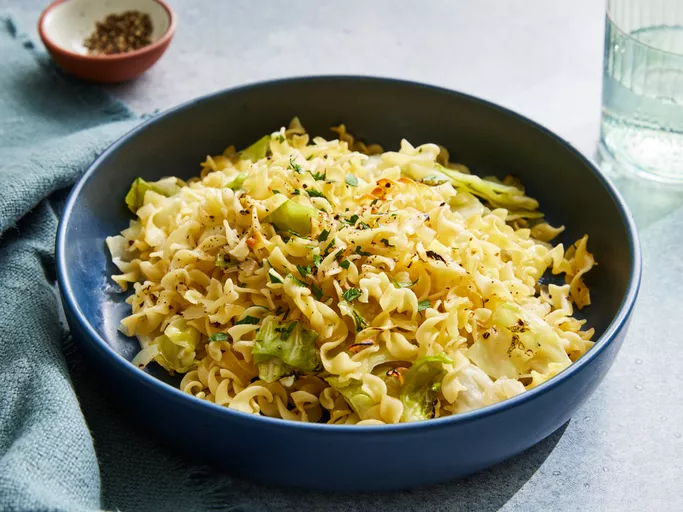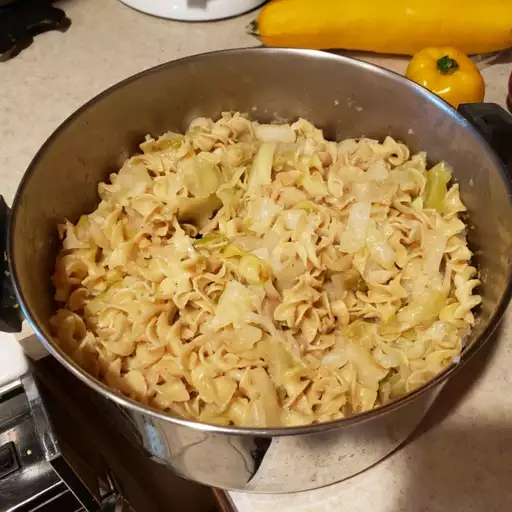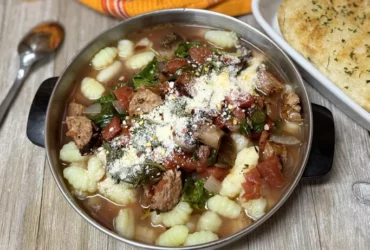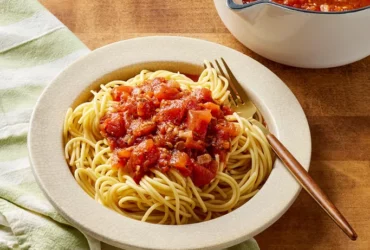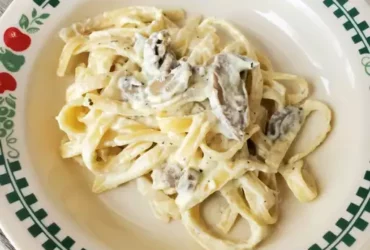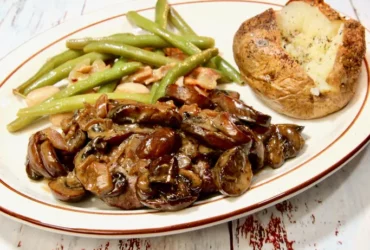What is Haluski
Cultural Significance
Haluski is a traditional Eastern European dish that originated among the Slovak and Carpathian Rusin immigrants who settled in the United States, particularly in areas with significant coal mining and steel industries.
The name “Haluski” is derived from the Slovak word for “noodles,” which was often used by the immigrant communities to refer to the homemade egg noodles that were a staple ingredient in this dish.
Haluski typically consists of sautéed cabbage, onions, and sometimes garlic, mixed with cooked noodles, usually made from wheat flour or a combination of wheat and other grains. The exact composition and preparation method can vary depending on regional traditions and individual preferences.
The cultural significance of Haluski lies in its ability to evoke memories and connections to one’s heritage and family history. For many people of Eastern European descent, especially those from Slovak, Hungarian, or Carpathian Rusin backgrounds, Haluski represents a tangible link to their ancestors’ culinary traditions and the struggles of their immigrant journey.
Haluski has also played an important role in preserving cultural identity and community cohesion within these immigrant groups. Sharing meals and cooking together has been a vital way for families and friends to strengthen social bonds, pass down recipes and stories, and maintain cultural practices despite geographical distances and generations of assimilation.
The recipe for Haluski often carries emotional significance as it is tied to special occasions such as holidays, family gatherings, or comforting moments during times of hardship. Preparing and serving this dish can evoke feelings of nostalgia, warmth, and belonging among those who share in its tradition.
As a cultural artifact, Haluski embodies the complexities and adaptations of immigrant cultures within a new country. It reflects the creative resilience of people seeking to preserve their heritage while navigating unfamiliar environments and forging new identities.
The significance of Haluski also extends beyond the confines of cultural heritage, as it represents a universal language that transcends national borders and spoken tongues. Sharing meals like Haluski allows individuals from diverse backgrounds to connect, forge common bonds, and experience the richness of collective culinary traditions.
Haluski, a traditional Eastern European dish, originated from Slovak and Hungarian immigrants who brought their culinary traditions to America.
- Haluski, a traditional Eastern European dish, originated from Slovak and Hungarian immigrants who brought their culinary traditions to America.
- The name Haluski is derived from the Slovak word for “small ears,” which refers to the shape of the noodles used in this hearty dish.
- Haluski typically consists of a combination of cabbage, cooked with onions and sometimes bacon or sausage, and served over a bed of homemade or store-bought noodles.
- The cabbage is usually shredded or chopped finely before being sautéed in butter or oil until it reaches a tender, slightly caramelized texture.
- Meanwhile, the noodles are cooked separately according to package instructions or traditional methods, such as kneading and boiling.
- The cooked noodles are then served under the bed of cabbage, creating a comforting and filling meal that is both flavorful and nutritious.
- In some variations of Haluski, additional ingredients are added, such as ground beef, pork, or mushrooms, to enhance the flavor and texture of the dish.
- Despite its simplicity, Haluski remains a beloved family recipe passed down through generations in many Eastern European-American households.
- This traditional dish has also gained popularity worldwide due to its accessibility and versatility, making it an excellent option for special occasions or everyday meals.
- Haluski’s unique flavor profile, which combines the sweetness of cabbage with the comfort of homemade noodles, continues to charm palates and hearts alike.
According to the Library of Congress, this hearty stew was created as a way for working class families to make use of readily available ingredients.
Haluski, also known as Halushki or Polish American noodle dish with cabbage, is a traditional Eastern European recipe that has been adapted by working-class families in the United States.
The origins of Haluski can be traced back to the Austro-Hungarian Empire, where it was known as “haluska,” a hearty stew made from potatoes, onions, and cabbage, often served with noodles or bread.
According to the Library of Congress, Haluski was created as a way for working-class families in Eastern Europe to make use of readily available ingredients during times of economic hardship. The dish was likely introduced to the United States by Polish immigrants who brought their culinary traditions with them.
Haluski typically consists of sautéed cabbage and onions, mixed with cooked noodles and sometimes bacon or ham. The dish is often served as a main course or side dish, and can be adapted to suit individual tastes and preferences.
In the United States, Haluski has become a popular comfort food, particularly in areas with large Polish-American populations. The recipe has been passed down through generations of families, with each household putting their own twist on the traditional recipe.
Haluski is often served during special occasions and holidays, such as Christmas Eve or Easter dinner. In many Polish-American households, it remains a beloved family tradition, serving as a reminder of cultural heritage and culinary roots.
Classic Haluski Recipe
Ingredients and Preparation
The Haluski dish is a classic Eastern European comfort food, especially popular among Polish, Slovak, Czech, and Hungarian communities. The name Halusky, or halušky in Slovak, literally translates to ‘little dumplings.’
This hearty recipe consists of two main ingredients: cabbage and noodles, making it a staple for many households during the colder months.
To make this delicious dish, you will need:
- 1 medium head of cabbage, shredded
- 8 ounces noodles (usually egg or potato noodles)
- 2 tablespoons butter
- 1 onion, chopped
- 1 teaspoon caraway seeds (optional, for an authentic flavor)
- Salt and pepper to taste
Here’s how you can prepare Haluski:
- Cook the noodles according to package instructions until al dente. Drain and set aside.
- In a large skillet, melt butter over medium heat. Add the chopped onion and cook until softened, about 3-4 minutes.
- Add the shredded cabbage to the skillet, stirring occasionally to prevent burning. Cook until the cabbage is tender and lightly browned.
- Combine cooked noodles with the cabbage mixture, then sprinkle caraway seeds, if using, over the top.
- Season with salt and pepper to taste and serve hot.
Haluski typically consists of a combination of cabbage, noodles, and sometimes sausage or bacon.
Haluski is a traditional Eastern European dish that has its roots in Slovak, Czech, and Polish cuisine.
The Classic Haluski recipe typically consists of a combination of cabbage, noodles, and sometimes sausage or bacon.
The dish is often associated with the coal regions of Pennsylvania where many Slovak immigrants settled in the late 19th and early 20th centuries.
Haluski was brought to America by these immigrant groups, who adapted their traditional recipes to use ingredients that were available locally.
Today, Haluski remains a beloved comfort food dish in many Eastern European-American households.
The Classic recipe begins with the cooking of cabbage, which is typically shredded or finely chopped before being sautéed in a pan with some oil until it’s soft and translucent.
While some recipes may call for the addition of sausage or bacon, the traditional Haluski recipe relies on the pure flavor of cabbage to provide depth and richness to the dish.
The cooked cabbage is then combined with noodles, which can be either fresh or dried. The noodles are usually a type of egg noodle or dumpling noodle that has been cooked according to package instructions.
To assemble the Haluski, the cooked cabbage and noodles are mixed together in a large bowl, often with some additional ingredients such as diced onions or grated carrots.
The mixture is then served hot, garnished with chopped fresh herbs like parsley or dill.
Haluski can be enjoyed on its own as a side dish or used as an ingredient in other recipes, such as stews or casseroles.
Its comforting flavor and satisfying texture make it a staple of many family gatherings and holiday meals.
This classic Haluski recipe has been passed down through generations of Slovak-American cooks, who have refined its preparation to create a dish that is both nostalgic and delicious.
According to the USDA’s official guide on traditional American recipes, this comforting dish can be prepared in about 30 minutes, using common pantry staples.
The Classic Haluski Recipe is a traditional American dish that combines cooked cabbage, noodles, and onions in a savory and comforting manner. The recipe is a staple in many Eastern European communities, particularly among Pennsylvania Dutch and Slovak immigrants who brought it to the United States.
This beloved recipe has been passed down through generations, with its roots dating back to the early 19th century. It’s a testament to the rich cultural heritage of American cuisine, which often reflects the traditions and customs of our immigrant ancestors.
Ingredients
- 8 oz (225g) noodles (typically egg noodles or wide eggless noodles)
- 1 medium onion, chopped
- 3 cups (700g) shredded cabbage
- 2 tablespoons (30g) butter or vegetable oil
- Salt and pepper to taste
To prepare the Classic Haluski Recipe according to the USDA’s official guide, follow these steps:
Step-by-Step Instructions
- Cook the Noodles: Bring a large pot of salted water to a boil and cook the noodles until they are al dente. Drain the noodles in a colander and set them aside.
- Sauté the Onions: In a large skillet or Dutch oven, melt the butter or heat the oil over medium heat. Add the chopped onion and sauté until it’s translucent and starting to caramelize.
- Add the Cabbage: Add the shredded cabbage to the skillet with the onions. Stir well to combine and let it cook for about 5-7 minutes, or until the cabbage starts to soften.
- Once the noodles are done cooking and the cabbage mixture is softened, combine them in a large serving dish. Season with salt and pepper to taste.
The Classic Haluski Recipe can be prepared in about 30 minutes, making it a quick and satisfying meal for any day of the week. It’s an excellent source of fiber and vitamins C and K, thanks to the cabbage and noodles. Enjoy this comforting dish with your family and friends!
Variations and Tips for the Perfect Haluski
Customizing the Recipe
The perfect Haluski dish is a matter of personal preference, but with some variations and tips, you can customize this traditional Eastern European recipe to suit your tastes.
Haluski, which literally translates to “noodle dumplings” in Slovakian, is a hearty and comforting side dish made from sautéed cabbage, noodles, and onions. The core ingredients are straightforward: cabbages, egg noodles, butter or oil, salt, pepper, and sometimes garlic or caraway seeds.
However, the beauty of Haluski lies in its versatility. You can tweak this recipe to create a dish that suits your dietary preferences and adds your personal touches.
One variation involves using different types of cabbage, such as napa, savoy, or red cabbage for added color and flavor contrast. You can also experiment with various noodle options like eggless noodles, rice vermicelli, or even gluten-free alternatives.
An additional tip is to use a mixture of sautéed onions and shallots to add depth to the dish. Simply cook them until caramelized, then mix with the cabbage and noodles for added sweetness.
Garlic lovers will enjoy mincing garlic and adding it to the oil or butter before cooking the cabbage. Start with a small amount (about 1-2 cloves) as you can always adjust to taste.
Cheese enthusiasts may prefer incorporating shredded cheddar, Parmesan, or even feta to add creaminess to Haluski. Sprinkle this over the dish and stir until combined for an added flavor dimension.
Finally, customize your serving experience by garnishing with fresh herbs like parsley, dill, or thyme. You can also consider adding some toasted breadcrumbs on top for added texture.
With these variations in mind, you’re well-equipped to create a unique and personalized Haluski dish that meets your culinary needs and satisfies your taste buds.
While traditional haluski is made with noodles, some variations substitute rice or dumplings for a unique twist.
The perfect haluski dish, a staple of Eastern European cuisine, is all about balance and harmony between its few, yet vital components: cabbage, noodles, and onions. However, even with such a simple recipe, room for experimentation and creativity exists.
One way to approach this dish is by considering it as a framework, rather than a strict set of instructions. Traditional haluski is made with noodles, but some variations substitute rice or dumplings for a unique twist. This allows the cook to adapt the recipe to their personal preferences and dietary needs, while still maintaining the essence of the dish.
For example, using rice instead of noodles can result in a lighter, more delicate flavor profile, while also reducing the overall calorie count. On the other hand, adding dumplings to the mix can add an interesting textural element, providing contrast to the softness of the cabbage and onions.
An important aspect of making perfect haluski is the choice of noodles or rice. Traditional haluski typically uses a type of egg noodle called “halusky,” which has a distinctive square shape and a slightly chewy texture. Other types of noodles, such as eggless or whole wheat noodles, can also be used to varying degrees of success.
When it comes to cooking the cabbage and onions, the key is to achieve a balance between caramelization and tenderness. The cabbage should be cooked until it’s slightly browned and tender, but still retains some crunch. Overcooking can result in a mushy texture that’s unappealing.
To add extra flavor and depth to the dish, consider adding aromatics such as garlic or caraway seeds to the onion mixture before cooking the cabbage. This will infuse the haluski with a rich, savory aroma that complements the natural sweetness of the cabbage.
An often-overlooked aspect of making perfect haluski is the importance of using fresh ingredients. The quality of the cabbage and onions can make or break the dish, so it’s essential to use the freshest possible produce. This will result in a more vibrant flavor profile and a texture that’s both crunchy and tender.
Finally, don’t be afraid to experiment and try new variations on the classic recipe. The beauty of haluski lies in its simplicity and adaptability, so feel free to add your own twist and make it your own.
Food historians at the University of Wisconsin note that this flexibility in recipe allows haluski to adapt to different tastes and dietary needs.
The traditional Haluski dish, consisting of cabbage and noodles, offers a wide range of variations to accommodate diverse tastes and dietary requirements. Food historians at the University of Wisconsin have noted that this flexibility allows haluski to adapt to various preferences.
Ingredient Variations
One common variation involves replacing traditional sausage with other meats or vegetarian alternatives.
- Bacon or pancetta can be used in place of sausage for a smokier flavor
- Vegans may substitute plant-based sausages, such as those made from tofu or tempeh
- Some recipes also use ground beef or pork instead of sausage
Another variation involves adding different types of onions or using various cooking methods to achieve a unique flavor profile.
- Caramelizing the onions can enhance their sweetness and depth of flavor
- Using red or yellow onions instead of white onions can add a pop of color and distinct taste
- Incorporating sautéed mushrooms can add an earthy flavor to the dish
Tips for the Perfect Haluski
To achieve the perfect haluski, it’s essential to cook the cabbage until it reaches a tender but still crisp texture.
- Cooking the cabbage in large batches and then draining excess water can help remove bitterness and preserve flavor
- Adding a splash of vinegar, such as apple cider or white wine vinegar, can balance out the sweetness of the cabbage
- To achieve a creamy sauce without heavy cream or butter, use a mixture of grated cheese and chicken broth to add richness and depth
The perfect haluski is a matter of personal preference, but incorporating these variations and tips can help you create a dish that suits your taste buds and dietary needs.
- Best Datanyze Alternatives for 2025 - April 24, 2025
- Best Hunter.io Alternatives for 2025 - April 22, 2025
- Best Lead411 Alternatives for 2025 - April 22, 2025

